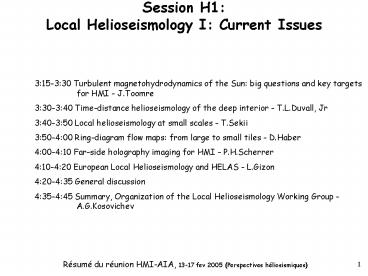Session H1: Local Helioseismology I: Current Issues - PowerPoint PPT Presentation
Title:
Session H1: Local Helioseismology I: Current Issues
Description:
Session H1: Local Helioseismology I: Current Issues 3:15-3:30 Turbulent magnetohydrodynamics of the Sun: big questions and key targets for HMI - J.Toomre – PowerPoint PPT presentation
Number of Views:6
Avg rating:3.0/5.0
Title: Session H1: Local Helioseismology I: Current Issues
1
Session H1Local Helioseismology I Current
Issues
315-330 Turbulent magnetohydrodynamics of the
Sun big questions and key targets for HMI -
J.Toomre 330-340 Time-distance helioseismology
of the deep interior - T.L.Duvall, Jr 340-350
Local helioseismology at small scales -
T.Sekii 350-400 Ring-diagram flow maps from
large to small tiles - D.Haber 400-410 Far-side
holography imaging for HMI - P.H.Scherrer 410-42
0 European Local Helioseismology and HELAS -
L.Gizon 420-435 General discussion 435-445
Summary, Organization of the Local
Helioseismology Working Group - A.G.Kosovichev
2
Session M1/H2Magnetic ActivitySunspots ARs
Bill Abbett - Introduction - 10 min Mats Carlsson
- From detailed magnetoconvection to simulations
of the convection zone-corona system - 20
min Doug Braun - Using helioseismology to probe
magnetic structures - 20 min Neal Hurlburt -
Linking models and observations - 5 min Tom
Berger - High resolution photospheric
observations - 5 min Brian Welsch - Inferring
surface flows from vector magnetograms - 5 min
3
Session H3Global seismologycurrent issues and
collaborations
115-120 Overview (emphasis on co-operation
issues -- Basu/Schou) 120-130 Gerard Thuilier
Picard 130-135 Discussion on Picard/HMI co-op
related issues 135-145 Frank Hill
GONG 145-155 Discussion leading from Hill's
talk 155-200 Overview Science issues
(Basu/Schou) 200-210 Mike Thompson Asphericity
etc. 210-215 Discussion leading from Thompson's
talk 215-245 General discussion of other
related issues Radius Change Asphericity and
magnetism Rotation, changes thereof Tachocline Str
ucture of CZ relation of EOS, composition Structu
re of outer layers
4
Session H4Local Helioseismology - Techniques
What problems do we face in making local
helioseismology techniques more reliable in time
for HMI? 316 - 330 Time-Distance Inversions
and Kernels for 3-D Ring Inversions - Aaron
Birch 330 - 340 Time-Distance Analysis - Tom
Duvall 340 - 350 Ring Analysis - Irene
Gonzalez-Hernandez 350 - 400 Holography - Doug
Braun 400 - 410 Progress in Direct Modelling -
Martin Woodard 410 - 440 Discussion on Basic
Problems Common to all - All 440 - 445 Wrap up
- Deborah Haber Possible problems for Ring and
Time-Distance Analysis, but with possible broader
implications 1. Foreshortening 2.
Background noise 3. Spatially varying MTF
effects (Instrumental FOV sensitivity) 4.
Image distortions 5. Magnetic effects
6. Leaks (e.g., apodization effects on FFT)
7. Projection deficiencies (All projections
are imperfect) 8. LOS effects (phase
changes, distortion from center-to-limb effective
height variations) 9. Carrington element
errors 10. Tracking choice 11.
Spectral line profile changes 12. Crosstalk
between observables 13. Mode Asymmetry
14. Temporal and Spatial filter sensitivity
15. Why are there spatially varying frequencies
or travel times across the disk? 16. How
should time-distance data cubes be filtered
before analysis?
5
Session H5Numerical Simulations Artificial
Data
1035-1040 Surface Simulations - Bob
Stein 1040-1047 Interior Simulations - Mark
Miesch 1047-1054 Wave Propagation Simulations -
Nagi Mansour 1054-1101 What do Time-Distance
Observers want from Simulators - Junwei
Zhao 1101-1108 What do Ring Diagam Observers
want from Simulators - Brad Hindman 1108-1115
What do Holography Observers want from Simulators
- Charlie Lindsey 1115-1150 Open Discussion -
What simulators can do / What observers want them
to do The purpose of this session for observers
to learn what simulators can and are planning to
do and for simulators to learn what they could do
that would be useful to observers.
6
Session H6Global Helioseismology Techniques
Data Products
1030-1040 Mike Thompson Inversions 1040-1050
Rachel Howe Inversions 1050-1110 Discussion
of inversion issues 1110-1120 Ed Rhodes Ridge
fitting 1120-1130 Sylvain Korzennik Ridge
fitting 1130-1140 Stuart Jefferies Global
spectrum fitting 1140-1200 Discussion of
spectrum fitting issues One view of the major
issues Improvement of exisiting fitting
and leakage matrix calulations development of
ridge fitting and global fitting and development
of near surface kernel calculations
and inversions.
7
Session H8Solar Subsurface Flows
- What progress has been made in this research
field and what is planned for future HMI
observations? - How can these HMI SSW maps be utilized?
- What can they tell us about supergranular and
giant-cell dynamics? - What are the connections to active regions and
coronal magnetic fields? - What type of synoptic and predictive information
can be obtained from these maps? - What physical parameters can be deduced from the
SSW data (e.g., vorticity, divergence, Reynolds
stresses, kinetic helicity, etc.)? - Where do you think we should concentrate our
future efforts? - What problems (distinct from technique issues)
need to be accomplished before launch? - What code development if any needs to be
performed before launch? - Should we organize special meetings or working
groups for this topic? - Speakers will include Junwei Zhao, Laurent
Gizon, Rudi Komm, Doug Braun and Brad Hindman
8
Session H9Near-Surface Seismology Effects
- Mark Rast "Excitation of Acoustic Waves by
Turbulence" - Junwei Zhao "Surface Effects Measured from
Time-Distance" - Ashley Crouch "Progress in Magnetohelioseismology
- Richard Wachter "Calibrating Helioseismic
Dopplergrams of Active Regions" - Sasha Kosovichev "Oscillations Caused by Solar
Flares" - Aaron Birch "Local Helioseismology of
Supergranulation and the Magnetic Network" - Konstantin Parchevsky "Near-Surface Simulations
of the Acoustic Field"
9
Session H10Solar Cycle, Dynamo
- Rachel Howe Global helioseismology - results,
challenges, and opportunities - Tom Duvall Local helioseismology - results,
challenges, and opportunities - Mark Miesch Dynamo models. What can they do for
helioseismology and what can observations do for
them?































